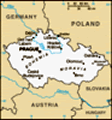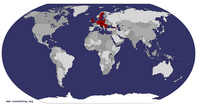Advertisement
Published: June 22nd 2009
Yesterday morning I stepped off my favourite scenic train line in the Czech Republic (the one that follows the Vltava and the Labe north of Prague) in a small town called Bohušovice nad Ohří, which is a kilometer south of Terezín, a town used as a Jewish ghetto during the second world war which had since been converted into a memorial, with various sites around the town open to visitors. It was one of those trips I would not recommend to anyone insecure about death, or emotionally fragile, because these things really can mess with your head.
As I did this trip independantly and without a tour or map, I found myself arriving foremost at the site you were obviously supposed to hit last - the cemetary. Most of it was converted into a large memorial ground with a few quite startling monuments overshadowing small numbered marble stubs in the ground, of which I never really worked out the significance. The crematorium itself was open for visitors converted into a small museum. This was the main place for corpses of prisoners who had died in the ghetto, or at the nearby concentration camp at Litoměřice, to be cremated. Inside, you

 Urns
Urns
these small boxes used to hold one corpse each - and there were over 30,000 of them in these chambers.see how these cremations were carried out in rustic black furnaces, economically able to convert about 5 corpses at once to ashes after they had been dissected in the room next door.
Having been cremated, the ashes from each furnace were poured into tiny urns which were kept in a room within the ghetto, which was the next site I found. This room, the columbarium, had been converted into a memorial hall with plaques all over the walls in memory of people who had died there. However, during the war, this was basically a storage room for boxes of ashes which the ghetto inmates and deceased people's relatives, at best, were led to believe would eventually be buried at a nonexistant cemetary in Prague. In reality, when the chambers became too full, the nazis simply dumped half of the urns in the river Ohře. To get them there, the child inmates of the Terezín ghetto were enslaved to load the urns into trucks - often containing the remains of their own family or friends, identifiable as each box of ashes had a tag attached.
There were certain other artifacts in here which I found a bit disturbing... the

 Carriage
Carriage
Terezín to Auschwitz in this.most eerie thing in this room had to be a collection of vials in the middle of one room, each with a sample of soil collected from the biggest concentration camps. Also, inmates from the ghetto who managed to survive (who were mostly children) were routinely transported to other sites, not only Litoměřice, but as far as Auschwitz or Lublin in these tiny carriages - obviously overpacked. Since a train journey nowadays from here to Oświęcim takes 6 hours, this I imagine entailed an entire day of being squished into this thing.. pretty horrific. I could have dwelled on this energy for a long, long time, and it was probably lucky I happened to be sharing the chamber with some obnoxiously loud American tourists, who made me want to run, and run I did.
After catching my breath, the final stop was in the town centre - all the other sites so far had been slightly outside. How anyone can possibly live in this town is beyond me. The buildings which used to be used as ghettos still have memorial plaques on the outside in rememberance people who were kept hostage there - and half of them are being

 wut
wut
I think even Foxtons would have trouble bigging this one up.or have been, in the apathetic nature of the Czech Republic, renovated and converted into apartments. Apartments which must contain the absolute worst energy in the country.
In the town centre was the main museum, which was... just a bit depressing. Most of the exhibitions were of creative works (art and poetry) by inmates of the ghetto, from childrens drawings of "memories of home" to older inmates more conceptual paintings, some of which were marvellous. I wish I could have taken some pictures, but this was obviously not allowed. Even when you hit a picture which could be seen as completely unrelated to wartime suffering, of which there were a few, you couldn't help feel depressed by it when you saw the tag at the bottom showing that its painter had died at Auschwitz, age 21.
I was far too out of my body to pay any attention to the factual exhibits here and refused to go any further without some Kofola. In the end I decided I had seen enough of Terezín, and hiked over the bridge to Litoměřice. I felt slightly intrigued by and apprehensive about this prospect, as I have been told by all my
czech friends back home in various words that every city in this region was just, well, shit. However, having seen former WW2 ghettos converted into flats, at this moment I could probably have unicycled naked through any one of them covered in magenta body paint, and felt more indifferent. Indeed, most of Litoměřice did look like a Sim City 4 game where the player had taken a line of coke, sent a tornado whirling around the edges of his city and rezoned all the destructed areas as "high density residential".
Walking over the river, you could just about spot the 2 old buildings on the skyline which had survived this process, both of which were on the town square. I stopped there for some chips and allowed the waitresses in the restaurant to come out one by one and laugh at my czech. Luckily, I was still digesting the Terezín memorial and the fact that this whole country is lolling at my attempts to speak their language were for once not bothering me. Instead I was eyeing up a certain hill I could see walking over the bridge and, seeing as there didn't seem to be much chance of
a storm, considering trying to walk up it. On the other side of the hill would have been the river and therefore, the train back to Prague.
After chips and ice cream, I waded out of the centre and through the panelák suburbs, which just seemed never ending... and suddenly, they ended, replacing themselves with countryside bungalows backing on to rough open spaces where fearless kestrels hovered feet above my head. Next thing, I was wading through fields of grass taller than I am, trying to dodge stinging nettles and stick to the nearest things to paths available. The higher up the hill I got, the grass got smaller as the surface got rockier and I had Litoměřice glaring back at me menacingly. I eventually reached some kind of summit, marked by a red pole and with a small clump of forest on the top, where I'm sure I caught a few deer out of the corner of my eye. A short field wading away was a wooden lookout tower, and the remnants of a wild barbecue party nearby.
The actual summit I was trying to reach, Radobýl hill, proved inaccessable with my gear (or lack of). From
where I was standing it looked as if it was just a few fields further, however it involved taking a very steep drop and going back up (probably with a scramble or two) through these yellow fields, which looked harmless from afar, but probably would have landed me with some acute poisoning and a lot of wasp stings had I gone in without insect repellent, which I didn't have. I therefore decided the hill had defeated me, and walked back to the smaller summit I'd reached before, trying to find a way around the absolute top of this hill so that I would get to the river on the other side.
Eventually I got to a village called Malíč Knobloška on a road junction, where I stupidly took a wrong turn, walked for almost an hour - away from the river! I arrived in another village, Kamýk, whose central road had a map for tourists attempting the regional cycle paths, showing me that I was a good 2 hours hike from Litoměřice or the place I would have ended up in had I gone over Radobýl hill. I was pretty tired and worried about the growing cloud cover, and
at first attempted to hitchhike back to a train stop, but despite being told this was definitely normal behaviour in ČR, 20 minutes of waiting got me nowhere.
So, I kept walking... since I was on a hill, I managed to spot a train going past on a track next to the river which told me that I could no way have been very far from a station, and it looked possible to reach without following the (presumably long winded) cycle path, but hopping over some more fields. This I did, and eventually arrived in Velké Zernoseky, where I waited an hour for a train to Všetaty and a connection back to Prague.
Back at Václavák, I don't think the words "Strips Menu, prosím" have ever been more appropriately spoken. Research on Google maps showed that I walked over 20km yesterday afternoon, hence the delayed update. Well, it definitely helped to digest everything I learned about Terezín. And reiterated that I need to prepare for these hikes in future!
Advertisement
Tot: 0.209s; Tpl: 0.014s; cc: 26; qc: 164; dbt: 0.1369s; 1; m:domysql w:travelblog (10.17.0.13); sld: 1;
; mem: 1.5mb













